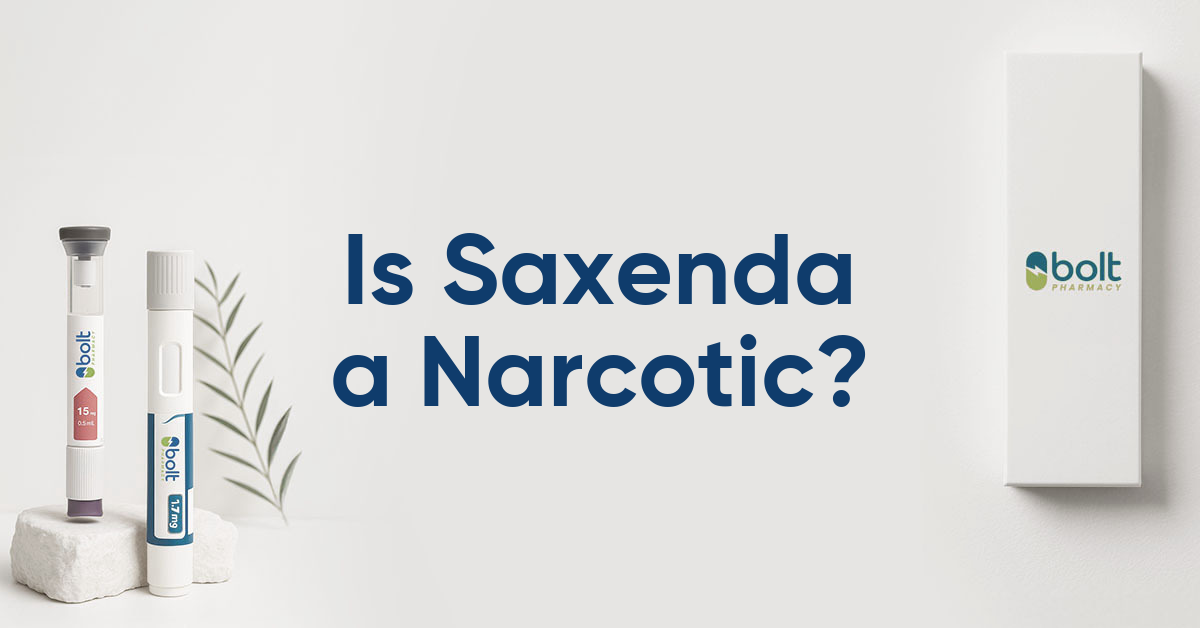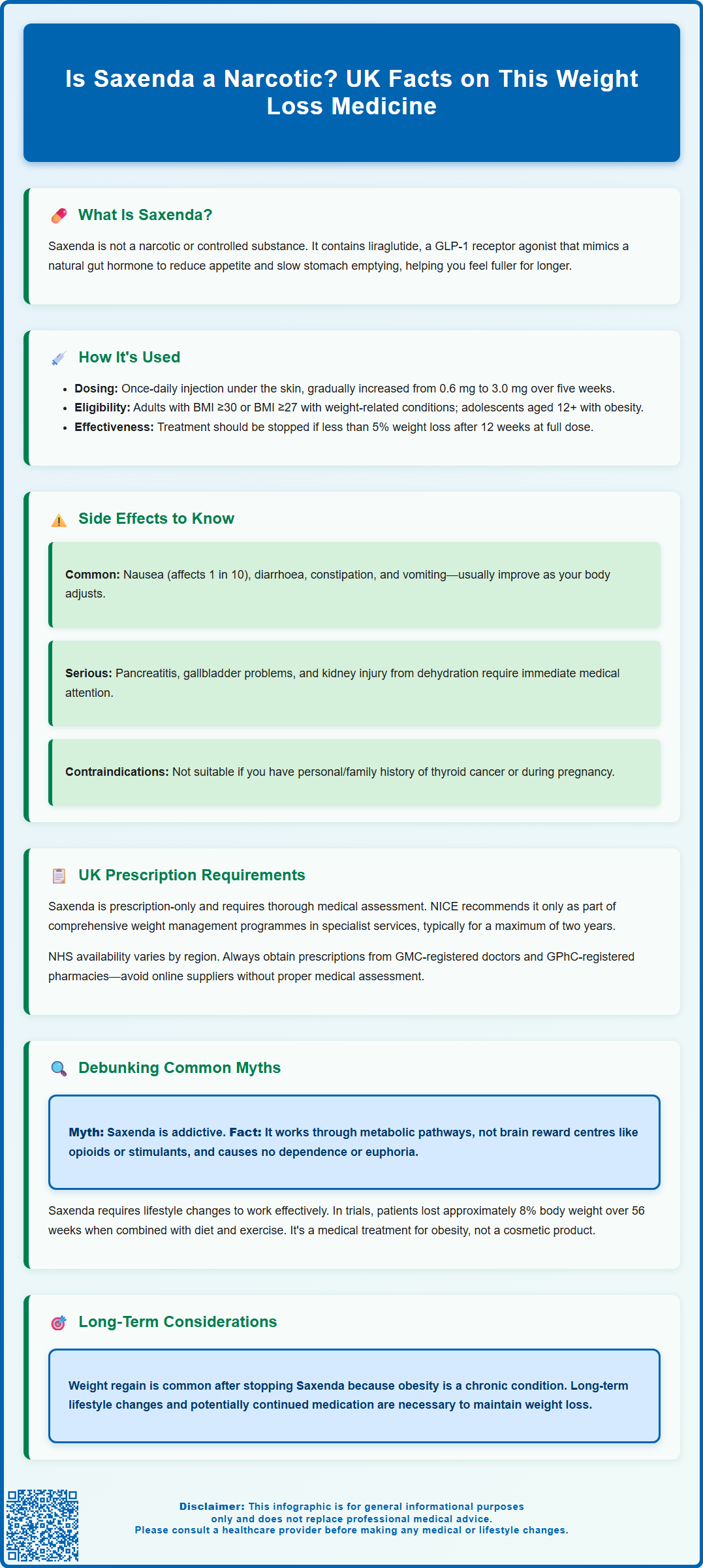Mounjaro®
Dual-agonist support that helps curb appetite, hunger, and cravings to drive substantial, sustained weight loss.
- ~22.5% average body weight loss
- Significant weight reduction
- Improves blood sugar levels
- Clinically proven weight loss

Is Saxenda a narcotic? This is a common question among patients considering weight management treatment. Saxenda (liraglutide) is definitively not a narcotic or controlled substance. It is a prescription-only medicine belonging to a class of medications called GLP-1 receptor agonists, which work by mimicking natural gut hormones to regulate appetite and support weight loss. Unlike narcotics such as opioids, Saxenda does not cause dependence, has no abuse potential, and is not regulated under the Misuse of Drugs Act 1971. Understanding what Saxenda is—and what it is not—helps patients make informed decisions about weight management options under appropriate medical supervision.
Summary: Saxenda is not a narcotic; it is a prescription GLP-1 receptor agonist used for weight management that does not cause dependence or abuse.
Saxenda is not a narcotic. It is a prescription-only medicine containing liraglutide, a glucagon-like peptide-1 (GLP-1) receptor agonist licensed for weight management. Saxenda belongs to an entirely different class of medications from narcotics (opioids) and is not a controlled drug under the Misuse of Drugs Regulations. It is not known to cause dependence or abuse and has no euphoria-producing effects.
The active ingredient, liraglutide, works by mimicking a naturally occurring hormone called GLP-1 that is released in the gut after eating. This mechanism produces several effects that support weight loss:
Appetite regulation: Saxenda acts on areas of the brain that control appetite, helping patients feel fuller for longer and reducing hunger between meals
Delayed gastric emptying: The medication slows the rate at which food leaves the stomach, contributing to prolonged satiety
Blood glucose regulation: Liraglutide has effects on insulin secretion when blood glucose levels are elevated, though Saxenda is not licensed for diabetes treatment
Saxenda is administered as a once-daily subcutaneous injection, typically in the abdomen, thigh, or upper arm. The dose is gradually increased over five weeks, starting at 0.6 mg daily and reaching the maintenance dose of 3.0 mg daily. This titration schedule helps minimise gastrointestinal side effects.
According to its UK licence (SmPC), Saxenda is indicated for weight management in adults with a body mass index (BMI) of 30 kg/m² or greater, or 27 kg/m² or greater with at least one weight-related comorbidity such as type 2 diabetes, hypertension, or dyslipidaemia. It is also licensed for weight management in adolescents aged 12 years and above with obesity.
However, NHS availability is more restricted. NICE guidance (TA664) recommends Saxenda only within specialist weight management services for adults who meet specific criteria, and usually for a maximum of two years. Treatment should be discontinued if patients have not lost at least 5% of their initial body weight after 12 weeks at the maintenance dose.

Saxenda has undergone rigorous clinical trials and regulatory assessment by the Medicines and Healthcare products Regulatory Agency (MHRA) and European Medicines Agency (EMA). Whilst generally well-tolerated, patients should be aware of potential adverse effects before commencing treatment.
The most common side effects are gastrointestinal and typically occur during the dose escalation phase. According to the SmPC, these include:
Nausea (very common, affecting more than 1 in 10 people)
Diarrhoea
Constipation
Vomiting
Abdominal pain or discomfort
Dyspepsia
These symptoms usually diminish over time as the body adjusts to the medication. Strategies to manage nausea include eating smaller, more frequent meals, avoiding spicy or fatty foods, eating slowly, and staying well-hydrated.
More serious but less common adverse effects require immediate medical attention:
Pancreatitis: Patients should contact their GP urgently if they experience severe, persistent abdominal pain that may radiate to the back, often accompanied by nausea and vomiting
Gallbladder problems: Symptoms include pain in the upper right abdomen, fever, yellowing of skin or eyes (jaundice)
Hypoglycaemia: Particularly in patients taking Saxenda alongside other diabetes medications such as sulphonylureas or insulin
Increased heart rate: Some patients may experience persistent tachycardia
Acute kidney injury: Usually secondary to severe dehydration from gastrointestinal side effects
The UK SmPC includes a warning about thyroid C-cell tumours observed in rodent studies, though the human relevance is unknown. As a precaution, Saxenda should not be used in patients with a personal or family history of medullary thyroid carcinoma or multiple endocrine neoplasia syndrome type 2.
Saxenda is contraindicated in pregnancy and is not recommended during breastfeeding. Women of childbearing potential should use contraception and discontinue Saxenda before planned pregnancy.
Patients should inform their healthcare provider of any pre-existing conditions, particularly kidney disease, liver disease, or a history of pancreatitis, before starting Saxenda. Regular monitoring and follow-up appointments are essential to assess treatment response and manage any emerging side effects.
Patients should report any suspected side effects to their healthcare professional or directly to the MHRA through the Yellow Card scheme (website or app).
Saxenda is a prescription-only medicine (POM) in the UK, meaning it can only be obtained through a registered healthcare professional following appropriate clinical assessment. This regulatory classification reflects the need for medical supervision when using weight management medications.
To prescribe Saxenda, healthcare professionals must:
Conduct a thorough medical history and physical examination
Calculate the patient's BMI and assess for weight-related comorbidities
Evaluate contraindications, including pregnancy or relevant medical conditions
Discuss realistic weight loss expectations and the importance of lifestyle modifications
Provide education on proper injection technique and storage requirements
Establish a monitoring plan with regular follow-up appointments
NICE guidance (TA664) recommends that Saxenda should only be prescribed as part of a comprehensive weight management programme within specialist weight management services. The guidance restricts NHS use to adults with specific BMI thresholds and comorbidities who have not responded to previous interventions, and treatment is usually limited to a maximum of two years.
The MHRA regulates Saxenda as a medicinal product, not a controlled substance. Unlike narcotics, which are subject to the Misuse of Drugs Act 1971 and require special prescription requirements, Saxenda follows standard prescription medicine regulations. There are no restrictions on prescription quantity beyond clinical appropriateness, and it does not require special storage in controlled drug cabinets.
NHS availability of Saxenda varies by region. Many Integrated Care Boards (ICBs) have restricted funding due to cost considerations and service capacity constraints, meaning patients may need to obtain it through private prescription. When prescribed privately, patients should ensure their prescriber is registered with the General Medical Council (GMC) and that the pharmacy is registered with the General Pharmaceutical Council (GPhC).
Patients should be cautious of online suppliers offering Saxenda without proper medical assessment, as these may be operating illegally and could supply counterfeit or substandard products. The MHRA advises patients to check for the distance selling logo on online pharmacy websites and to report suspected falsified medicines through appropriate channels.
Several misconceptions surround weight loss medications like Saxenda, often stemming from misunderstanding about how these medicines work and their regulatory status.
Misconception 1: Weight loss medications are narcotics or addictive substances
This is incorrect. Saxenda and similar GLP-1 receptor agonists are not controlled drugs and are not known to cause dependence or abuse. They work through metabolic and hormonal pathways rather than affecting reward centres in the brain like opioids or stimulants. There is no evidence linking Saxenda to substance abuse potential.
Misconception 2: Weight loss medications are a 'quick fix' requiring no lifestyle changes
Saxenda is not a standalone solution for weight management. Clinical trials demonstrate that the medication is most effective when combined with a reduced-calorie diet and increased physical activity. In pivotal trials, patients typically lost an average of approximately 8% of their initial body weight over 56 weeks when adhering to a comprehensive programme, though individual results vary. Without lifestyle modifications, results are significantly diminished.
Misconception 3: All weight loss medications work the same way
Different weight loss medications have distinct mechanisms of action. Whilst Saxenda works through GLP-1 receptor activation, other medications like orlistat reduce fat absorption in the gut. Understanding these differences is crucial for appropriate prescribing. In the UK, the main licensed options for weight management are orlistat and GLP-1 receptor agonists (liraglutide, semaglutide) within their specific indications.
Misconception 4: Weight loss medications are cosmetic treatments
Saxenda is licensed for medical weight management in patients with obesity or overweight with comorbidities—conditions associated with serious health risks including type 2 diabetes, cardiovascular disease, and certain cancers. It is a therapeutic intervention for a chronic disease, not a cosmetic product.
Misconception 5: Once you stop the medication, weight loss is permanent
Obesity is a chronic, relapsing condition. Many patients regain weight after discontinuing Saxenda, which is why long-term lifestyle changes and ongoing support are essential. Some patients may require continued pharmacological treatment alongside behavioural interventions to maintain weight loss.
Patients considering Saxenda should have realistic expectations and understand that successful weight management requires commitment to long-term dietary and activity changes. Healthcare professionals should provide balanced information about benefits, limitations, and potential risks to support informed decision-making, in line with NICE guidance.
No, Saxenda does not cause addiction or dependence. It is a GLP-1 receptor agonist that works through metabolic and hormonal pathways, not by affecting reward centres in the brain like narcotics or stimulants, and has no known abuse potential.
No, Saxenda follows standard prescription-only medicine regulations and does not require the special prescriptions needed for controlled drugs. However, it must be prescribed by a registered healthcare professional following appropriate clinical assessment.
NHS availability is restricted. NICE guidance recommends Saxenda only within specialist weight management services for adults meeting specific BMI and comorbidity criteria, usually for a maximum of two years, though many ICBs have limited funding due to cost considerations.
The health-related content published on this site is based on credible scientific sources and is periodically reviewed to ensure accuracy and relevance. Although we aim to reflect the most current medical knowledge, the material is meant for general education and awareness only.
The information on this site is not a substitute for professional medical advice. For any health concerns, please speak with a qualified medical professional. By using this information, you acknowledge responsibility for any decisions made and understand we are not liable for any consequences that may result.
Lorem ipsum dolor sit amet, consectetur adipiscing elit, sed do eiusmod tempor incididunt ut labore et dolore magna aliqua. Ut enim ad minim veniam, quis nostrud exercitation ullamco laboris nisi ut aliquip ex ea commodo consequat. Duis aute irure dolor in reprehenderit in voluptate velit esse cillum dolore eu fugiat nulla pariatur.
Block quote
Ordered list
Unordered list
Bold text
Emphasis
Superscript
Subscript